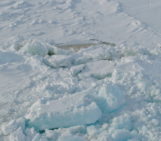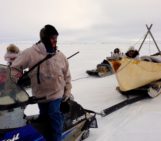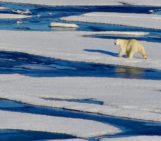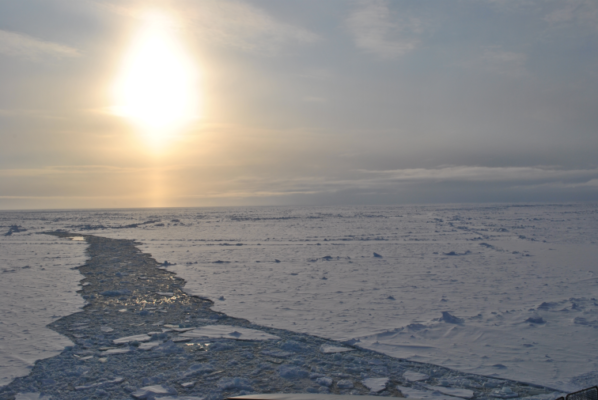
Each year, the Arctic sea ice goes through a cycle of melting and freezing. From March to September, sea ice gradually melts and becomes thinner, and from October to March, the water freezes again. In our warming climate, we see that more and more ice melts each year. One would expect that the ice would also freeze less, but we have observed that the ice growth – or ice production – has increased over the last decades. Yes, you read it right: despite warming, there is more ice produced during winter than before!
Ice growth-thickness feedback
How can that be even though the Arctic is warming much faster in winter than in summer (Bintanja & van der Linden, 2013)? The main reason for this apparent contradiction is that the ice nowadays is much thinner, and thinner ice can grow much faster than thicker ice. Think of a lake in winter: once the lake is cool enough, the ice takes only a few days to grow 5-10 cm, but once the ice has grown a bit, it takes much longer to grow another 5-10 cm. The sea ice grows (see also this and this blog post) from below, but the ice is cooled from above by the atmosphere. This means that all the heat released during freezing (or the ‘cold’ necessary for freezing) must travel through the ice, and these heat fluxes get smaller the thicker the ice is. This effect is a negative feedback, as it counteracts the general sea ice loss caused by warming; this is the growth-thickness feedback (Bitz & Roe, 2004).
One way the growth-thickness feedback manifests, is through the fact that nowadays, there are larger areas of the Arctic Ocean with no ice (i.e., open water) in late summer, and ice grows the fastest once it just starts freezing, since it is very thin at that point. So, the increase in open water area at the end of summer is also part of the growth feedback.
Other factors influencing ice production
But the growth-thickness feedback is not the only effect which has increased the winter ice production in the Arctic. The sea ice is usually covered by snow, and snow further protects the ice from the cold atmosphere. So, the more snow there is on the ice, the slower it will grow. Snow on sea ice is difficult to measure, but we think that the snow cover will become thinner in the future, especially in the regions of the Arctic where the sea ice melts away each summer. Part of the increase in ice production could therefore also be due to a thinner snow cover.
Another effect which is important for ice production are strong winds which break up the ice during winter and form leads or polynyas, which are areas of open water within the ice pack. In this open water, ice can grow very quickly. As the ice is becoming thinner, it is also moving faster due to winds and leads form more easily. We typically measure how much the ice is broken apart by the divergence. Divergence is a measure of how quickly things spread apart. Increasing divergence during winter could be a reason why ice production has increased because more ice is spread apart, which creating leads where new ice can be produced fast.
The tug-of-war between temperature and feedbacks
What will happen in the future? Will ice production increase further (see also this and this blog post)? Climate models indicate that at some point, the ice production will hit a peak and will decrease afterwards. The main reason for this is that the increasing temperatures will eventually overcome all the feedbacks I mentioned. First, as it gets warmer, the winters become shorter, and the ice has less time to freeze — this is already happening. Second, higher temperatures during winter will also slow down the growth itself. So, inevitably, the ice production will decrease in the future. The question is: when will that be? This depends on how long the effects I described above can fight against the increasing temperatures. How long until those negative feedbacks are overcome by global warming itself? And which of the effects will give up first?
In our recent study, we built a simple linear model that can explain changes in ice production and separate the different effects of the mechanisms: the snow depth, the available open water area at the start of winter, the divergence during winter, the ocean temperature at the beginning of the winter, and the air temperature during winter. We focused on a specific region in the Arctic Ocean: the Kara and Laptev Seas, sometimes called the ‘ice factories’ in the Arctic Ocean, because a lot of ice is produced there during winter. In Figure 1, you can see that a lot of ice is produced in this region, because ice is often pushed away from the coast by the winds, which creates open water (remember: divergence), where ice can growth quickly.
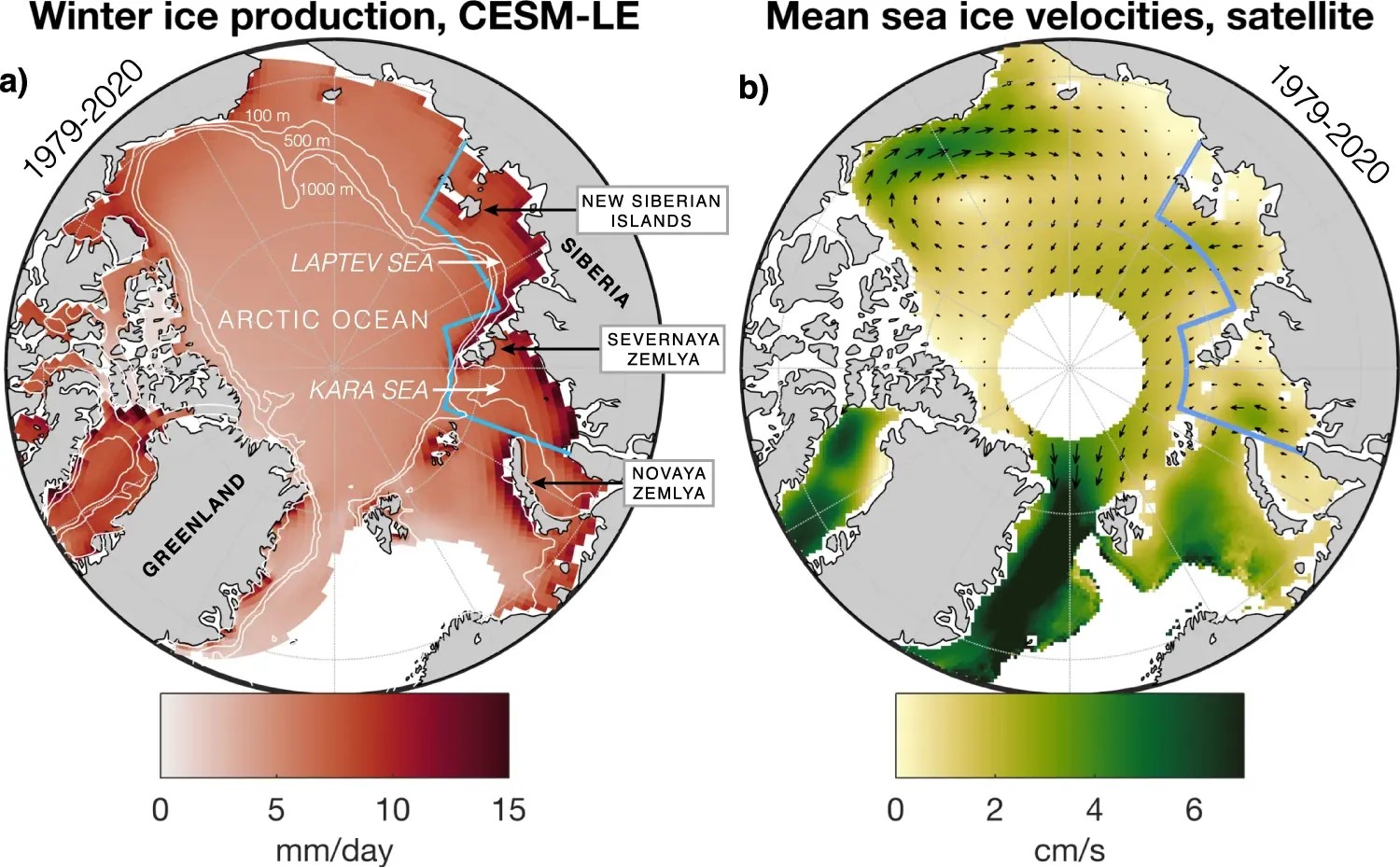
Figure 1: a) Winter ice production in a climate model and b) mean winds from satellite observations. Both are averages over 1979-2020. The blue line surrounds the study area: The Kara and Laptev Seas. [Credit: Cornish et al., 2022]
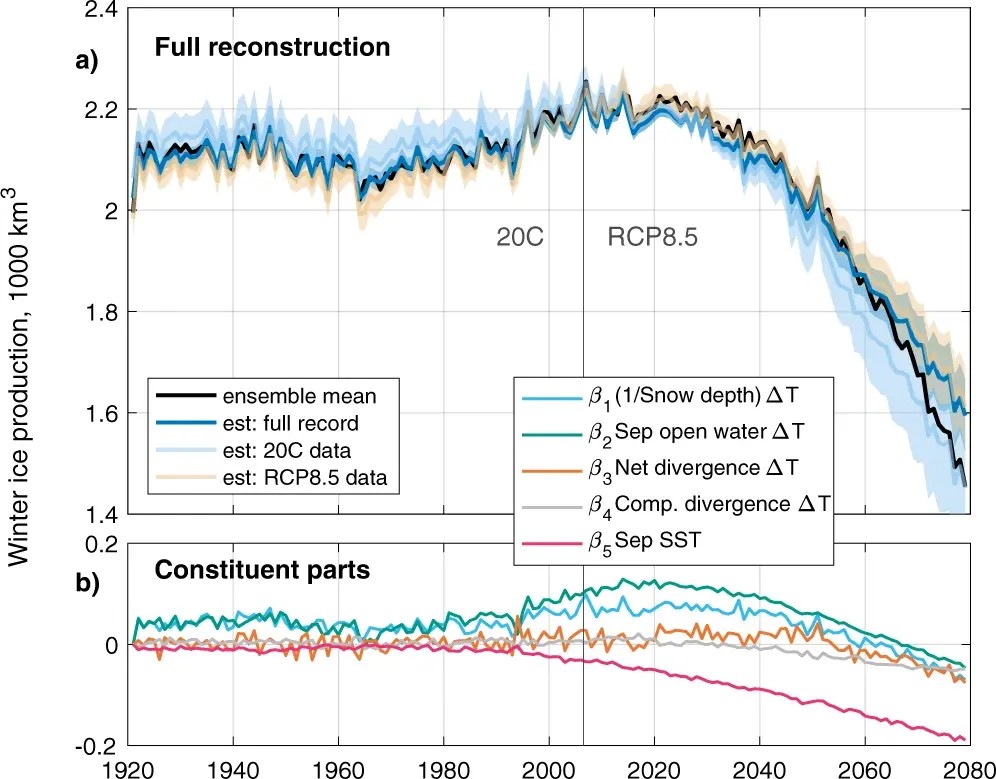
Figure 2: a) Total winter ice production in the Kara and Laptev Seas in the climate model and in the simple linear model. b) The contribution of the different mechanisms and feedbacks in the simple model to the total ice production in the climate model. [Credit: Cornish et al., 2022]
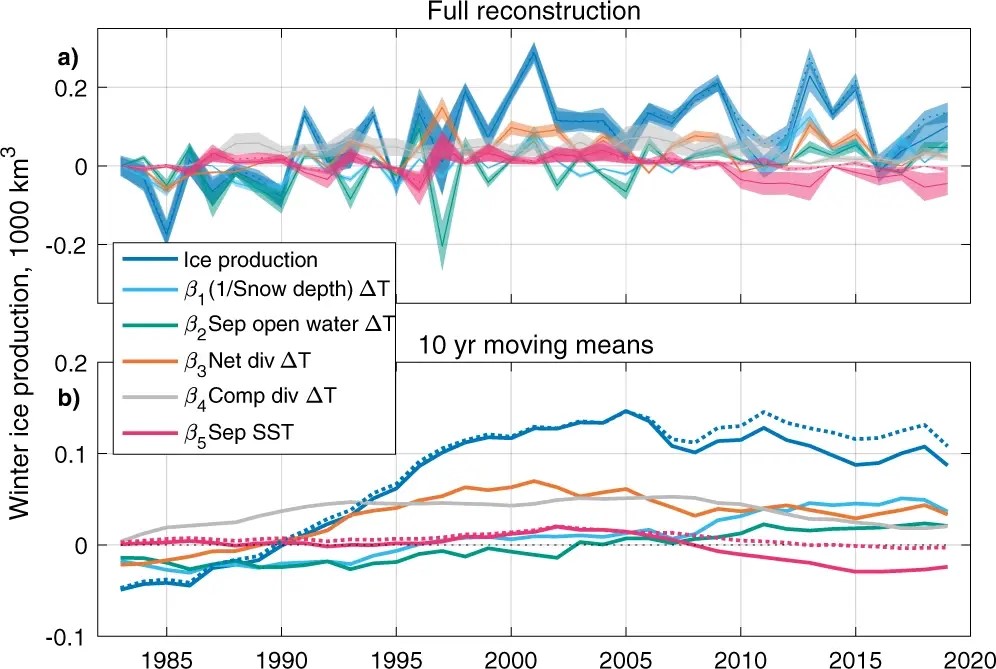
Figure 3: a) Total ice production (relative to 1982/83) estimated from observations and the contributions of the different mechanisms and feedbacks in the simple model. b) as a), but smoothed curves to see the differences more clearly. [Credit: Cornish et al., 2022]
To summarize, there are several negative feedbacks that have managed to increase the ice production in the Arctic, despite Arctic warming and overall sea ice decline. However, these feedbacks are slowly losing the fight with increasing temperatures, which means that ice production will start to decrease in the future.
Further reading
Highlighted paper: Cornish et al. (2022). Rise and fall of sea ice production in the Arctic Ocean’s ice factories, Nature Communications 13(1), 7800.
Previous Cryoblog posts about sea ice microbes and about the interaction between sea ice and the atmosphere
Edited by Stefan Thiele and Loeka Jongejans
 Jakob Dörr is a PhD candidate in climate dynamics at University of Bergen, working on the winter Arctic sea ice. He uses a combination of climate models and observations to understand which large-scale drivers influence the winter sea ice in the Barents Sea and the rest of the Arctic Ocean, now and in the future. Jakob tweets as @doerr_jakob. Email: jakob.dorr@uib.no
Jakob Dörr is a PhD candidate in climate dynamics at University of Bergen, working on the winter Arctic sea ice. He uses a combination of climate models and observations to understand which large-scale drivers influence the winter sea ice in the Barents Sea and the rest of the Arctic Ocean, now and in the future. Jakob tweets as @doerr_jakob. Email: jakob.dorr@uib.no

